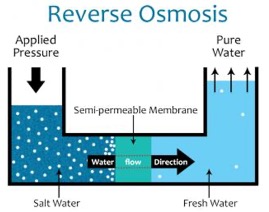Desalination Technology
26-08-2023
12:12 PM

What’s in today’s article?
- Why in News?
- What is Desalination Technology?
- RO Desalination
- Environmental Issues with RO Desalination Plants
- Is RO Water Good for Health?
- Alternative to RO Desalination Technology
- News Summary
- About National Institute of Ocean Technology (NIOT)
Why in News?
- Chennai-based National Institute of Ocean Technology (NIOT) will set up a Desalination plant in Lakshadweep.

What is Desalination Technology?
- Desalination refers to the removal of salts and minerals from water.
- Today there are two main types of desalination technologies –
- Reverse Osmosis
- Thermal Desalination
RO Desalination
- Reverse Osmosis (RO) desalination uses the principle of osmosis to remove salt and other impurities, by transferring water through a series of semi-permeable membranes.

Image Caption: Reverse Osmosis
- Osmosis involves ‘a solvent’ (such as water) naturally moving from an area of low solute concentration, through a membrane, to an area of high solute concentration.
- A reverse osmosis system applies an external pressure to reverse the natural flow of solvent and so seawater or brackish water is pressurized against one surface of the membrane.
- This pressure causes salt-depleted water to move across the membrane, releasing clean water from the low-pressure side.
- Seawater has Total Dissolved Solids (TDS) i.e., a measure of salinity, close to 35,000 parts per million (ppm), or equivalent to 35 g of salt per one litre/kg of water.
- An effective network of RO plants reduces this down to about 200-500 ppm.
- There are about 18,000 desalination plants in the world across 150 countries and nearly half of Israel’s water is sourced through desalination.
Environmental Issues with RO Desalination Plants
- Desalination is an expensive way of generating drinking water as it requires a high amount of energy.
- The other major environmental challenge it poses is the deposition of Brine (highly concentrated salt water) along the shores.
- The brine being deposited along the seashore is triggering changes along the coastline and reducing the availability of prawn, sardine and mackerel.
- Hyper salinity along the shore affects plankton, which is the main food for several of these fish species.
- Moreover, the high-pressure motors needed to draw in the seawater end up sucking in small fish and life forms, thereby crushing and killing them.
Is RO Water Good for Health?
- Earlier, there were concerns that desalinated water was devoid of vital minerals such as calcium, magnesium, zinc, sodium, potassium and carbonates, referred to as TDS.
- Highly desalinated water has a TDS of less than 50 milligrams per litre, which is pure, but does not taste like water.
- However, anything from 100 mg/l to 600 mg/l is considered as good quality potable water.
- In today’s times, most RO plants put the water through a ‘post-treatment’ process whereby salts are added to make TDS around 300 mg/l.
- Several of the home-RO systems that are common in affluent Indian homes also employ post-treatment and add salts to water.
Alternative to RO Desalination Technology
- Low-temperature Thermal Desalination (LTTD) –
- LTTD technique works on the principle that water in the ocean 1,000 or 2,000 feet below is about 40 C to 80 C colder than surface water.
- Salty surface water is collected in a tank and subject to high pressure (via an external power source).
- This pressured water vaporizes and this is trapped in tubes or a chamber.
- Cold water plumbed from the ocean depths is passed over these tubes and the vapor condenses into fresh water and the resulting salt diverted away.
- LTTD Plants in India –
- In 2005, National Institute of Ocean Technology (NIOT), set up a 100,000 litre-a-day plant in Kavaratti, Lakshadweep islands and this has been providing water to about 10,000 residents.
- There are also 1.5 lakh litres a day plants proposed at Amini, Androth, Chetlat, Kadamat, Kalpeni and Kiltan islands.
- There are plants of similar capacity proposed at Minicoy and Agatti islands.
News Summary
- The National Institute of Ocean Technology (NIOT) is planning to set up a Desalination plant in Lakshadweep. The plant will be emission free.
- Currently the desalination plants, each of which provides at least 100,000 litres of potable water every day, are powered by diesel generator sets.
- The need for diesel power to reduce the water pressure means that the process is not fossil-fuel free.
- Also, diesel is a precious commodity in the islands as it has to be shipped from the mainland critical for powering the electric grid.
- Currently there are five desalination plants in operation in the Lakshadweep islands. Four more were expected to be functioning in the coming months.
- The proposed self-sustaining plant — the 10th — is expected to be ready later this year.
About National Institute of Ocean Technology (NIOT)
- The NIOT was established in 1993 as an autonomous society under the Ministry of Earth Sciences.
- Objective – To develop reliable indigenous technologies to solve various engineering problems associated with harvesting of non-living and living resources in the Indian Exclusive Economic Zone (EEZ) which is about two-thirds of the land area of India.
- Headquarters – Chennai, Tamil Nadu
Q1) What is Osmosis in simple terms?
In biology, osmosis is the movement of water molecules from a solution with a high concentration of water molecules to a solution with a lower concentration of water molecules, through a cell's partially permeable membrane.
Q2) What is Brackish Water?
Brackish water is a broad term used to describe water that is more saline than freshwater but less saline than true marine environments. Often these are transitional areas between fresh and marine waters. An estuary, which is the part of a river that meets the sea, is the best known example of brackish water.
Source: NIOT to set up green, self-powered Desalination Plant in Lakshadweep | Indian Express
